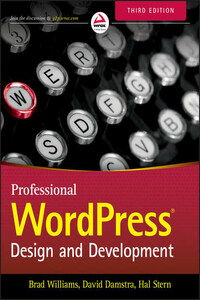Professional WordPress. Design and Development

The highest rated WordPress development and design book on the market is back with an all new third edition.
Professional WordPress is the only WordPress book targeted to developers, with advanced content that exploits the full functionality of the most popular CMS in the world. Fully updated to align with WordPress 4.1, this edition has updated examples with all new screenshots, and full exploration of additional tasks made possible by the latest tools and features. You will gain insight into real projects that currently use WordPress as an application framework, as well as the basic usage and functionality of the system from a developer's perspective. The book's key features include detailed information and real-world examples that illustrate the concepts and techniques at work, plus code downloads and examples accessible through the companion website. Written by practicing WordPress developers, the content of this edition focuses on real world application of WordPress concepts that extend beyond the current WordPress version.
WordPress started in 2003 with a single bit of code to enhance the typography of everyday writing, and has grown to be the largest self-hosted website platform in the world. This book helps you use WordPress efficiently, effectively, and professionally, with new ideas and expert perspectives on full system exploitation.
Get up to speed on the new features in WordPress 4.1
Learn cutting edge uses of WordPress, including real-world projects
Discover how to migrate existing websites to WordPress
Understand current best practices and tools in WordPress development
WordPress was born out of a desire for an elegant, well-architected personal publishing system built on PHP and MySQL, and has evolved to be used as a full content management system through thousands of plugins, widgets, and themes. Professional WordPress is the essential developer's guide to this multifunctional system.







